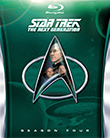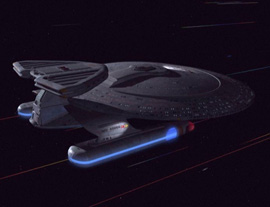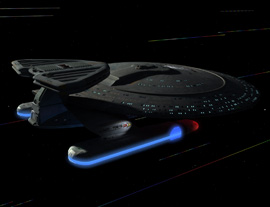Two years ago, fans thought it would be impossible that a show like Star Trek: The Next Generation could ever be remastered in high definition. Like spinoffs Deep Space Nine and Voyager, TNG was originally shot on film but subsequently edited at video resolution.
Thanks to CBS’s faith in Star Trek as a product and a strong determination to preserve it at HD resolution for future generations, an unprecedented remastering project was green-lit. The project goes back to the original 35mm camera negatives of The Next Generation, with the team at CBS Digital rebuilding each episode shot-by-shot in a similar fashion to how the show would have been produced back in the 1980s. Visual Effects are being freshly composited using the latest software available and planets and CG effects are being rendered from scratch with a keen sense for detail and authenticity.
The Challenges of Reproducing CG Work
A key difference between TNG and later shows is its dependence on physical models over CG elements. This gave CBS a huge advantage in the remastering project, as the majority of 35mm footage of the physical models still existed in the Paramount vaults. Of course, different passes (model, matte, lighting elements etc.) of shots have to be recomposited, but this is a far less daunting prospect than having to reconstruct CG models from scratch.
On the few occasions where CG models were used in The Next Generation – the most notable being the Crystalline entity from “Datalore” and “Silicon Avatar” – Niel Wray and his CG team at CBS Digital have to start from scratch in building the elements. Any original files that may have been used to render the shot back in the day have long since been lost. As any CG artist will tell you, rendering shots in CG is complicated enough, but when you have to reproduce something, not only in appearance but in motion, the level of difficulty grows almost exponentially.

Considering a show like Deep Space Nine which relies so heavily on CG models (especially in the last two seasons), the task of reproducing 50 different CG ships following complicated flight paths, firing at each other and exploding left right and center in grand battle sequences would border on the impossible given time, financial and resource constraints in any DS9 Remastering project.
Original CG Assets
It’s long since been the belief of fans – and indeed CBS – that the scene files used back in the 1990s to render these CG shots have long since been lost. After all, it was far easier to neglect computer files than it was rolls of physical film. Couple that with how hard disc space was such a valuable commodity 15 years ago, and an assumption that the original files were lost or simply overwritten could certainly be believable.
 As part of an upcoming feature profiling the original CG artists who worked on Deep Space Nine, Voyager and Enterprise, I set about researching and contacting a number of the team who were responsible for CG work back in the day for effects houses such as Foundation Imaging and Eden FX. A startling breakthrough came during an interview with former Senior CG Supervisor Robert Bonchune who worked on all three post-TNG spinoffs and won a host of Emmys for his CG work on several famous episodes. During the interview – which will be published later this month – Bonchune revealed that he still has in his possession all of the original CG scene files which he worked on during his time working on Star Trek.
As part of an upcoming feature profiling the original CG artists who worked on Deep Space Nine, Voyager and Enterprise, I set about researching and contacting a number of the team who were responsible for CG work back in the day for effects houses such as Foundation Imaging and Eden FX. A startling breakthrough came during an interview with former Senior CG Supervisor Robert Bonchune who worked on all three post-TNG spinoffs and won a host of Emmys for his CG work on several famous episodes. During the interview – which will be published later this month – Bonchune revealed that he still has in his possession all of the original CG scene files which he worked on during his time working on Star Trek.
CG work on Deep Space Nine was originally split between two FX houses, Digital Muse and Foundation Imaging, as Bonchune explained:
Digital Muse was doing most of the work on Deep Space Nine – I don’t know if they’d changed their name to Eden FX – but they did most of the CG for that show. We [Foundation] did a fair amount of work for that show as well, but I can’t say that we were regularly doing weekly work on DS9. We were certainly part of the bigger shows, because they just didn’t have the capacity to do it all; it just needed two big teams.
The spaceship stuff is a little easier. If you have all of the assets – all the ships that are needed – and you load the scene file, theoretically, if it loads all the ships with textures it needs, then yes, you’d just hit ‘render.’
[Deep Space Nine] is much more difficult for the last three [seasons] because of the combination of CG and motion control – and when there was CG, it was usually those massive, full-blown war scenes. Going back and revisiting it isn’t as simple as just hitting ‘render’, but it’s still pretty straightforward.
Bonchune went on to describe how he has all of the original assets for not only his work with Foundation Imaging on Deep Space Nine, but also the vast majority of Star Trek: Voyager:
Unless someone has some fantastic algorithm for up-rezzing to make it HD quality – and I guess that could be possible – but to redo it is to virtually start over from scratch. You’re talking about what they did for the Original Series, getting a real team to sit down and redo basically everything from the third season on, almost from scratch.
If they ask one of us – and if they use a team that uses LightWave – it’ll be much easier for them to redo… because the guys who worked on it, like me, have the assets. We have the original ships; we have most of everything that was used [in the making of the series]. That would eliminate a ton of the cost of rebuilding.
So, how would I approach it? The same way I did at the time – I’d figure out what was done in CG, and we’d just start from there. And today, it would be easier! Literally, you could just load the scene files and hit ‘render’ – it would be done! I mean, not everything… but a lot more than you’d think.
Quality of the Assets: Do They Hold Up In HD?
What’s more, Bonchune went on to reveal in our interview that while he was working in CGI and Digital Effects on Star Trek, a large amount of work was purposefully over-built with the team putting in a huge amount of detail which could never be seen at standard definition, but which makes a re-render in high definition all the more tantalizing:
…If it was built by my team, it was overbuilt. It’ll hold up. I would be more surprised to see something that doesn’t hold up. I would be shocked if it doesn’t hold up to high definition.
This was an absolute revelation to me, and made even more surreal by how calmly Rob Bonchune announced the news in our telephone interview. Clearly, the potential ramifications for any remastering of Deep Space Nine and Voyager are huge. Given access to the original scene files which were used to create the show’s CG sequences, the difficulty of remastering DS9 and Voyager would be considerably reduced and a transition to HD would appear far more feasible than if CBS had to start from scratch.
I asked Rob if he would be so gracious as to provide TrekCore with an exclusive sample of an HD re-rendered still from his archive of assets. He was all too eager to agree and show off how well the work done by the team at Foundation holds up in HD, 15 years after it was first produced.
The shot in question shows the USS Honshu, a Nebula-Class ship featured in the 6th Season Deep Space Nine episode “Waltz“.
The sheer quality of the re-rendered shot blew me away when I first received it. Rob was certainly correct when he said the team “over-built” the models back in the day – there is a stunning amount of detail that comes through in the HD render, from the patterning of the hull plating to the escape pod hatches to the tiny ship’s registry number on the top of the ship’s sensor platform – this is one impressively made CG model. If this is any indication of the type of quality inherent in the original scene files, then not only would it make a high-definition remastering of the show far more feasible economically- and practically-speaking, but by referring back to the original files, you have the opportunity to preserve the show’s original artistic direction and match the look as closely as is humanly possible.
In Summary
- Star Trek: Deep Space Nine and Voyager are far more challenging to remaster in HD due to their use of CG. Until now, the original assets used to create these CG shots were presumed lost.
- Through talking to original artists such as Robert Bonchune, I discovered that a large number of the assets still exist for these shows.
- The scene files can be accessed using current technology relatively easily.
- A large amount of the work produced originally was over-built and should hold up well when re-rendered in high definition.
 | Order Star Trek: The Next Generation Season 4 Blu-ray today! |  | Order TNG - "Redemption" Feature Blu-Ray today! |
|---|


